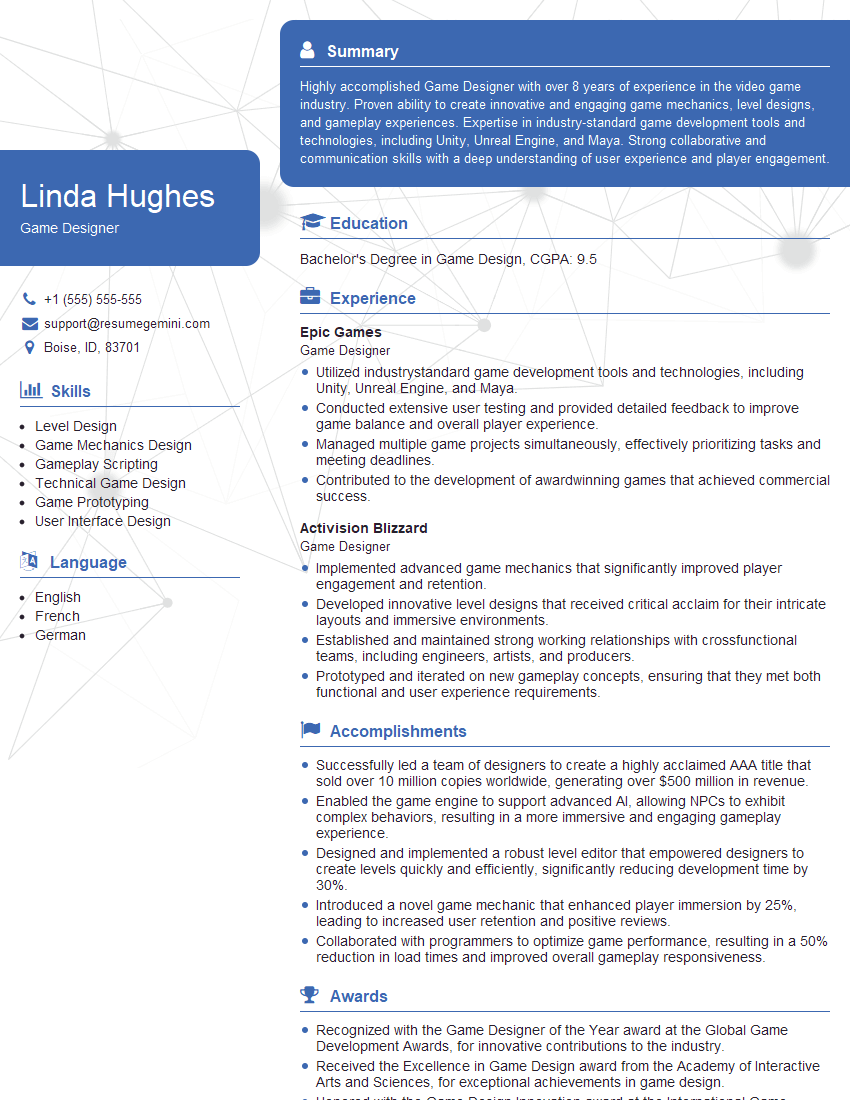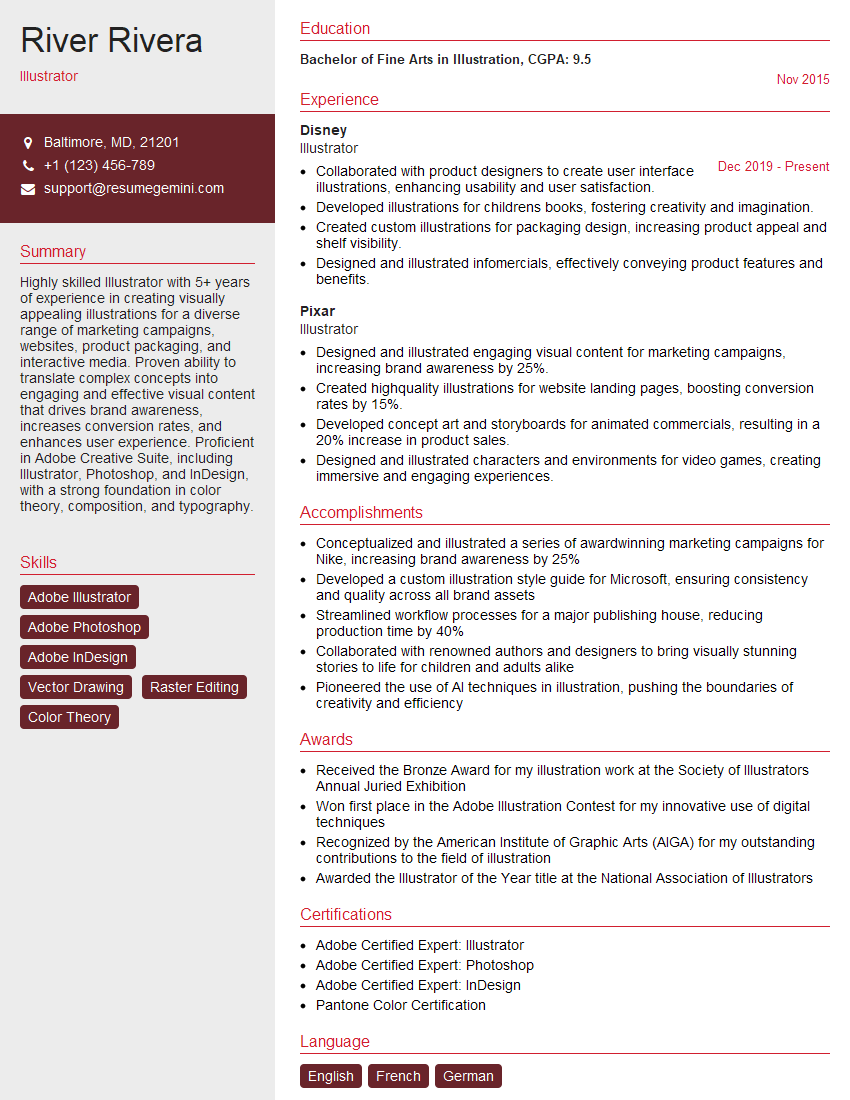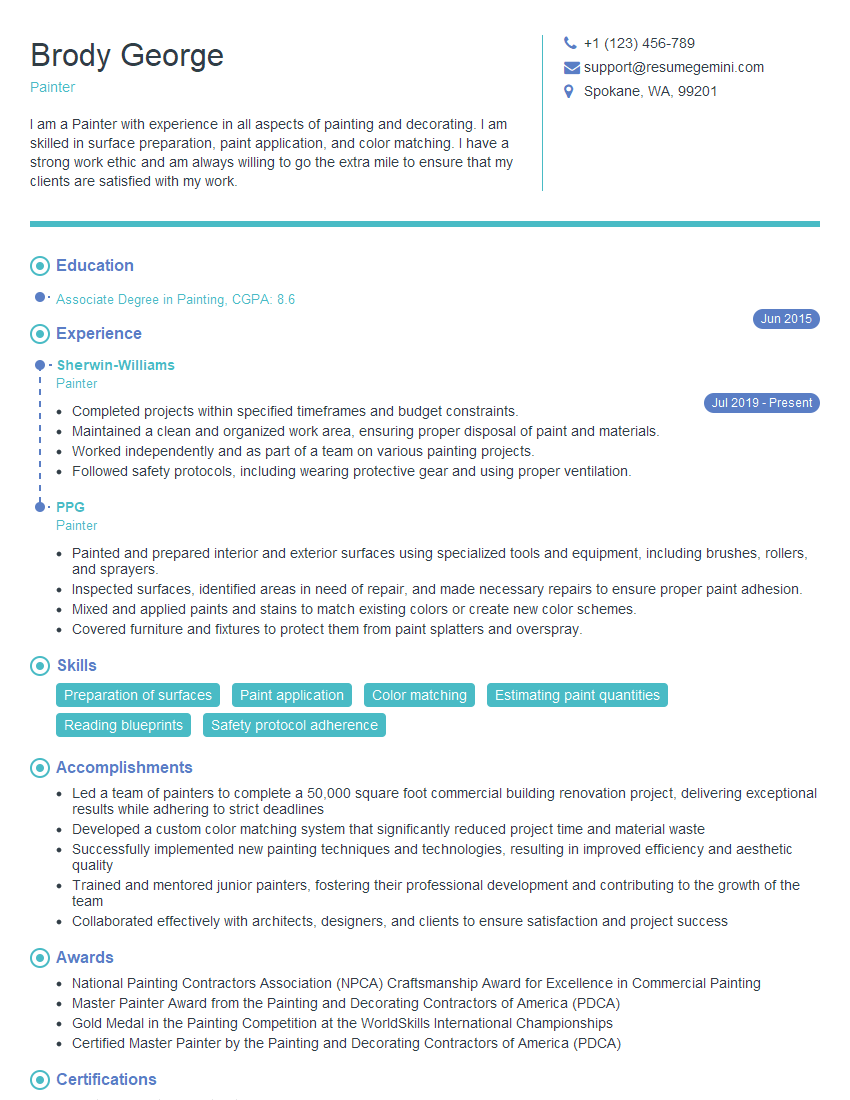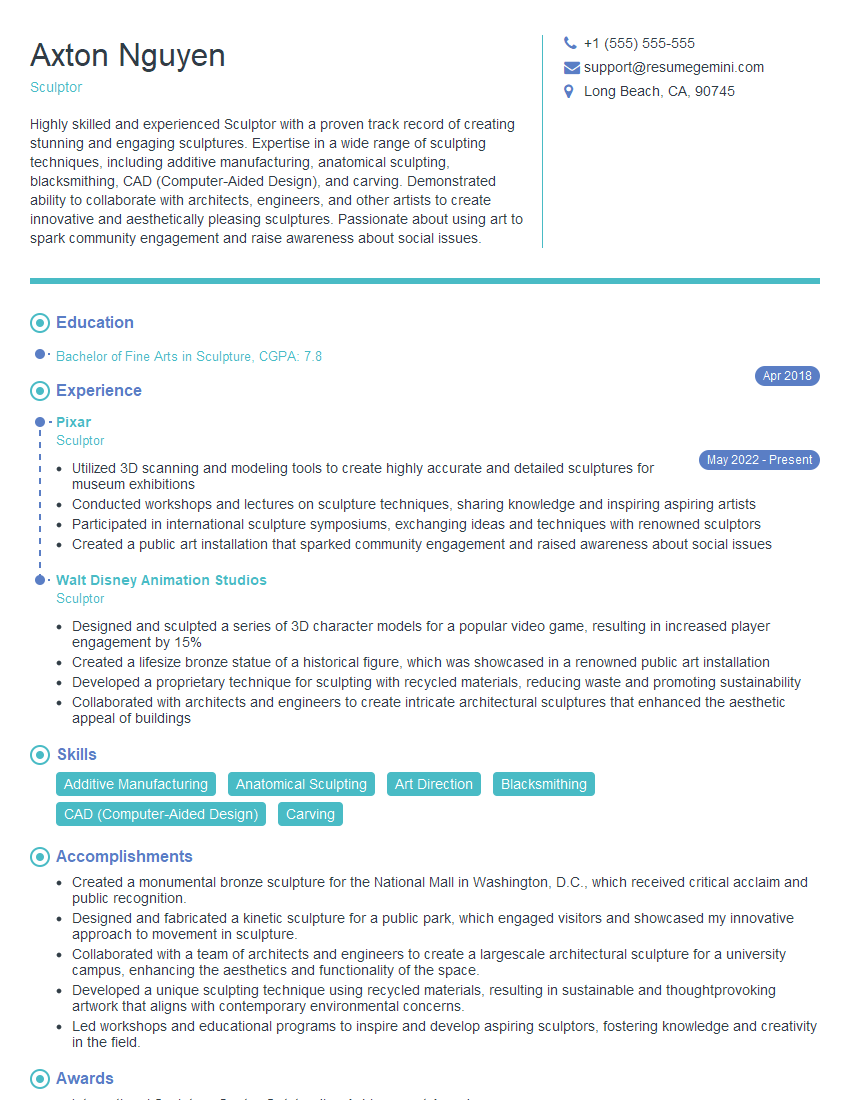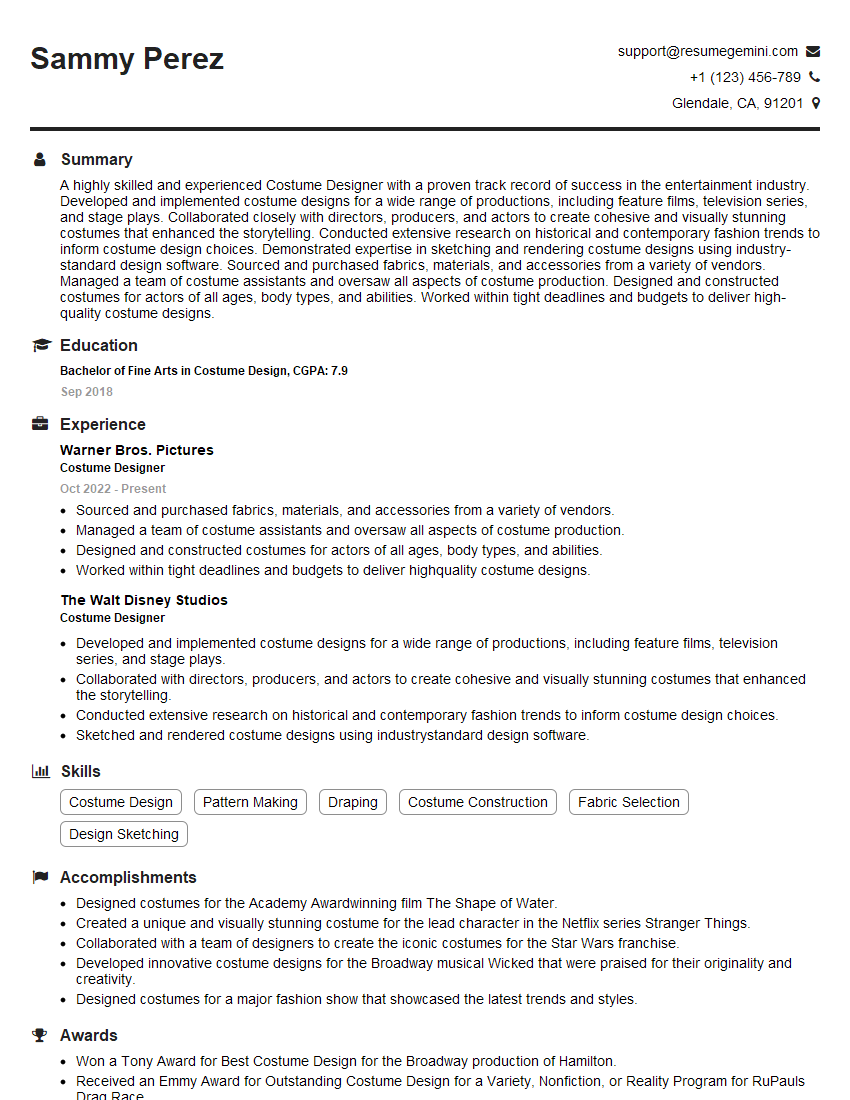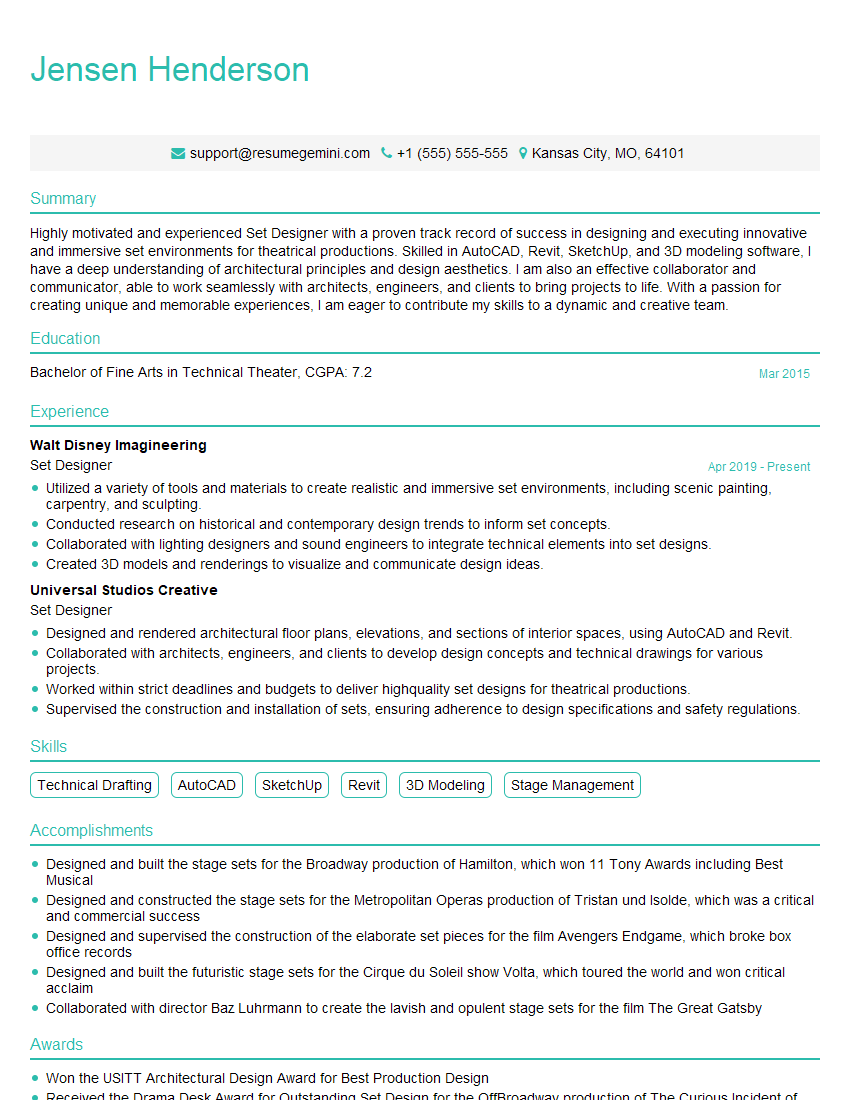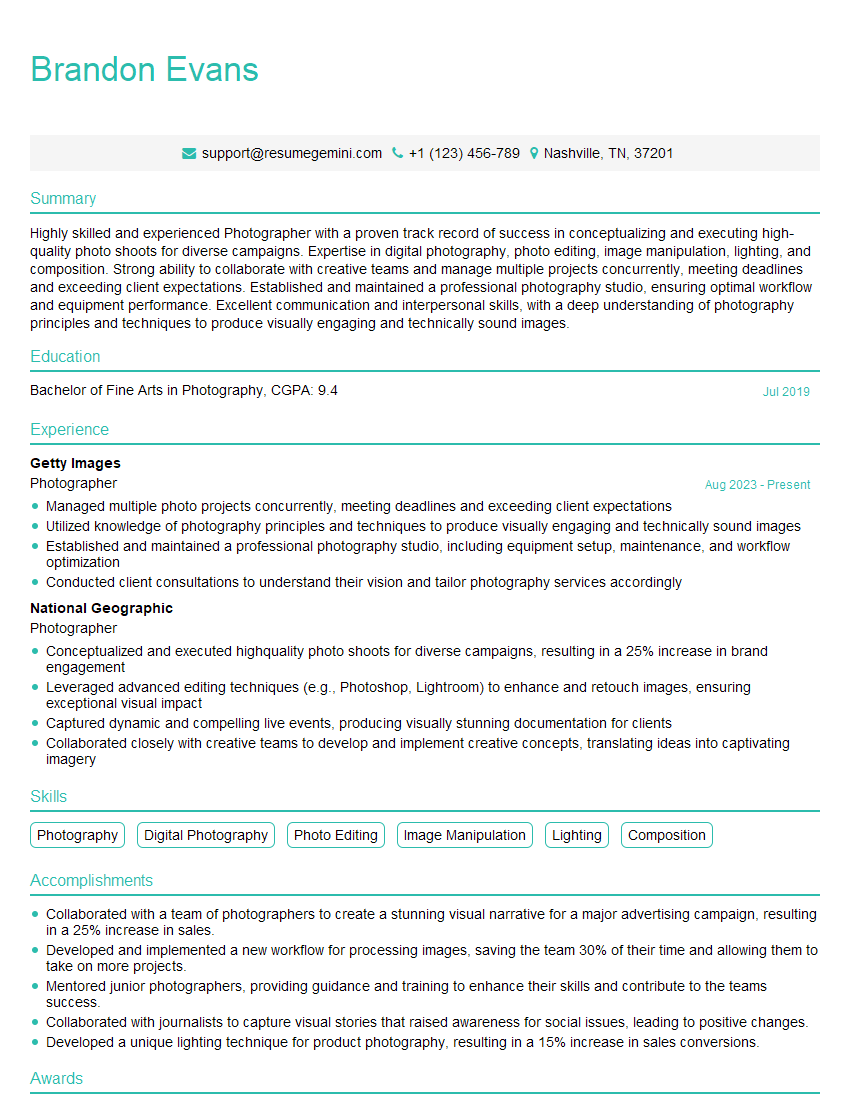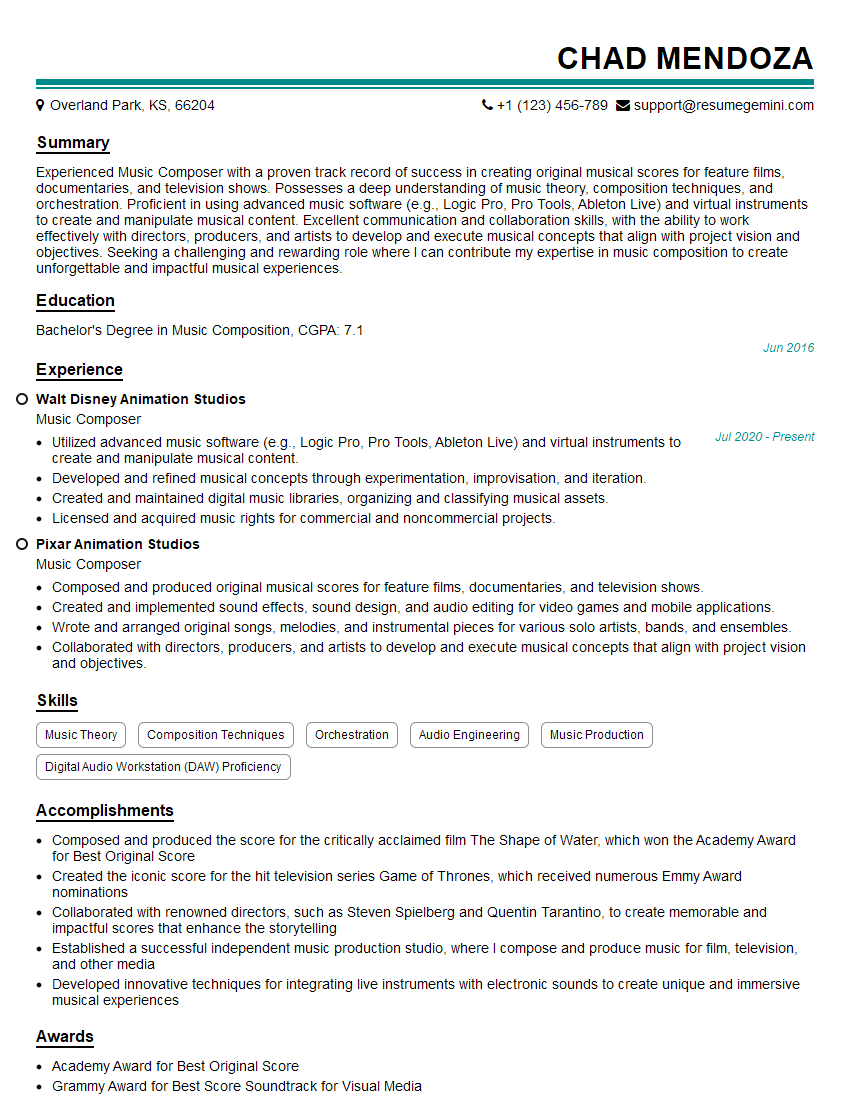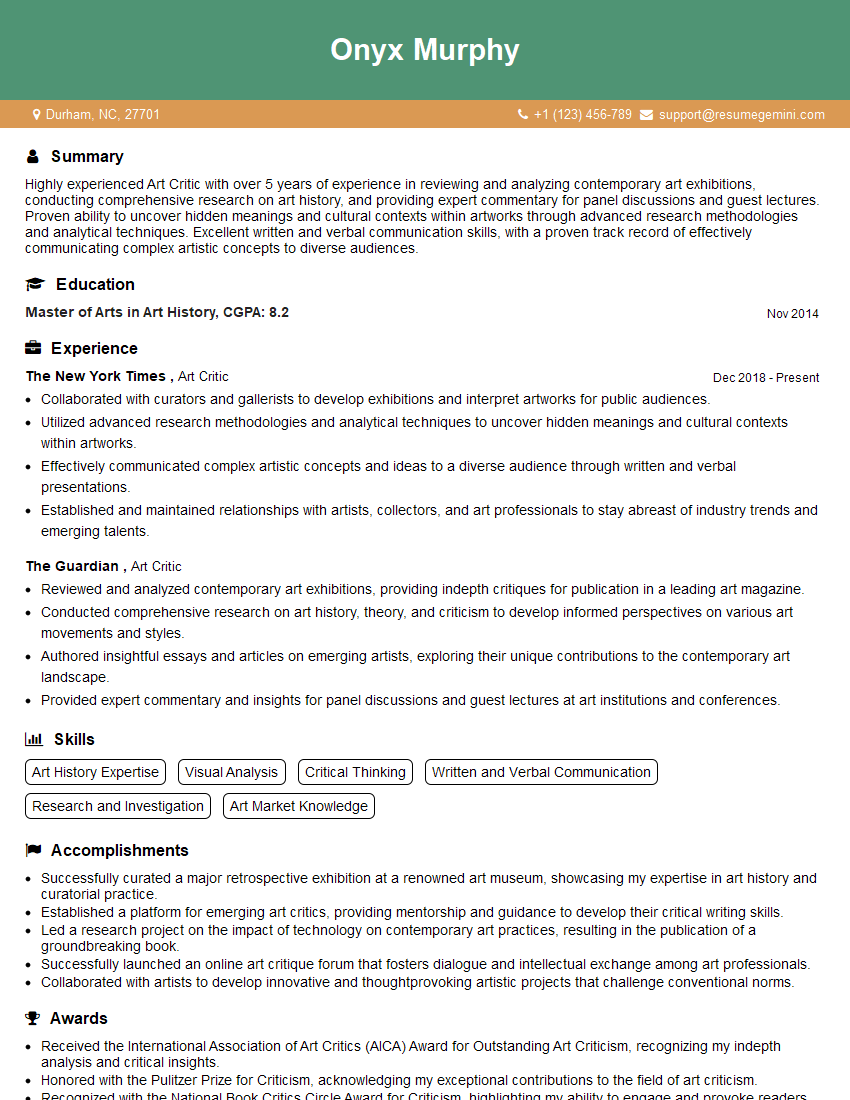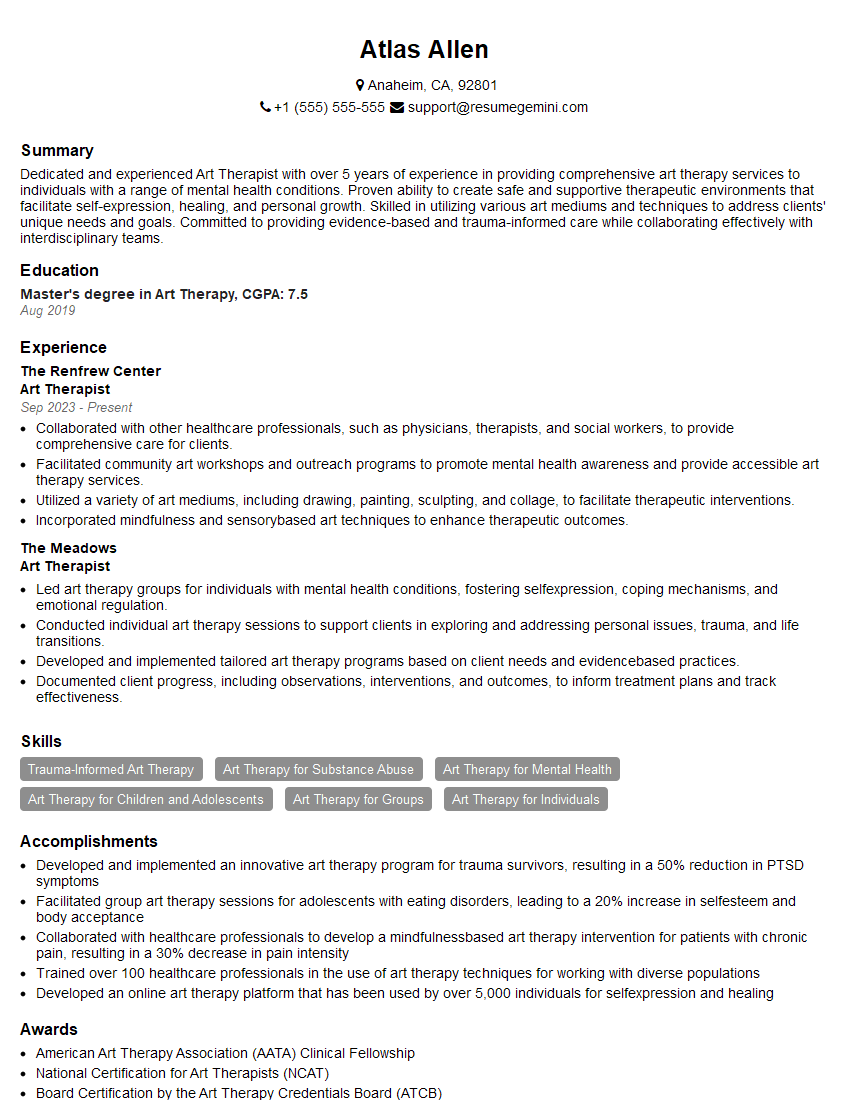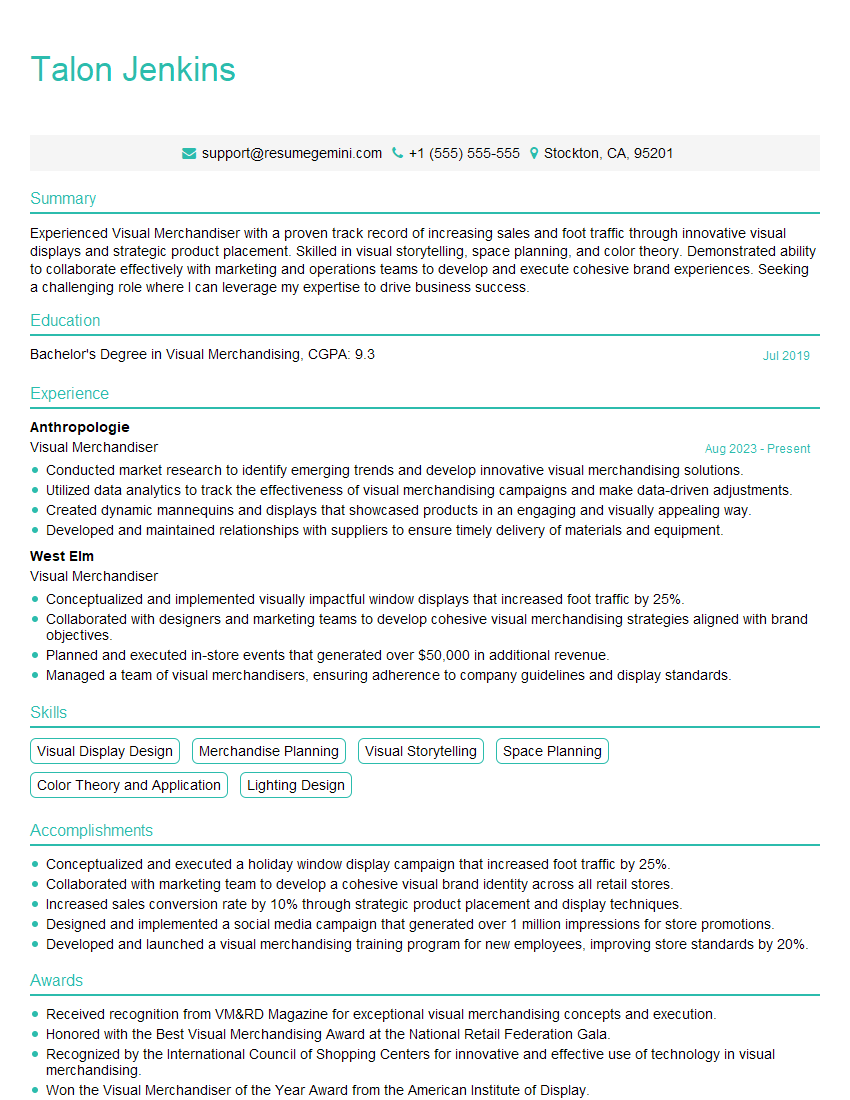Every successful interview starts with knowing what to expect. In this blog, we’ll take you through the top Artistic Sensitivity interview questions, breaking them down with expert tips to help you deliver impactful answers. Step into your next interview fully prepared and ready to succeed.
Questions Asked in Artistic Sensitivity Interview
Q 1. How do you define ‘artistic sensitivity’ in the context of your work?
Artistic sensitivity, in my work, encompasses a profound awareness and responsiveness to the nuances of aesthetic experience. It’s not merely about technical skill, but a deep-seated understanding of visual language, emotional resonance, and the power of form and composition to communicate meaning. It involves a keen eye for detail, an ability to perceive subtle relationships between elements, and a commitment to creating work that is both visually captivating and emotionally engaging. This sensitivity informs every decision I make, from the initial concept to the final execution.
For instance, it means choosing a specific shade of blue not just for its visual appeal, but also for its psychological associations – a calm, tranquil blue might evoke serenity, while a vibrant electric blue could represent energy and excitement. The choice wouldn’t be arbitrary, but driven by a conscious understanding of the desired effect.
Q 2. Describe a time you had to balance aesthetic considerations with practical limitations.
During a recent mural project, I faced a significant challenge. The aesthetic vision called for intricate, highly detailed brushstrokes, reflecting a specific artistic movement. However, the wall was situated in direct sunlight, creating immense practical limitations. The intense heat significantly affected the paint’s drying time, causing cracking and uneven application. To balance aesthetic considerations with these practical constraints, I adapted my technique. I employed a faster-drying paint specifically designed for high-heat conditions and simplified the detail level, focusing on the key visual elements while maintaining the artistic style’s essence. This required a compromise, but the final result, though slightly less detailed than initially envisioned, still captured the spirit and intent of the original design and held up beautifully in the harsh conditions.
Q 3. How do you approach a design project when the client’s vision clashes with your artistic sensibilities?
When a client’s vision clashes with my artistic sensibilities, I engage in a collaborative dialogue, focusing on mutual understanding. I begin by actively listening to their vision and asking clarifying questions to understand the underlying needs and motivations. I then present my artistic perspective, not as a rigid standpoint, but as a series of possibilities and explorations. We work together to find a middle ground, identifying areas of compromise and synergy. This process might involve presenting mood boards, sketches, and alternative design concepts that incorporate elements of both the client’s vision and my artistic interpretation. It’s a delicate dance, one that prioritizes open communication and mutual respect, aiming to create a final product that both satisfies the client’s requirements and maintains artistic integrity.
For example, a client might want a logo in a specific font that I find aesthetically unappealing. Instead of rejecting their suggestion outright, I might propose slight modifications, suggesting alternative colors or treatments that might make the font more visually engaging within the overall context of the design.
Q 4. Explain your process for translating abstract ideas into tangible artistic expression.
Translating abstract ideas into tangible artistic expression is a multi-stage process for me. It begins with a period of exploration and brainstorming, often involving sketching, journaling, and gathering inspiration from various sources. I might create mood boards, collect textures, and experiment with color palettes to define the emotional tone and visual language of the piece. Once I have a solid conceptual foundation, I move into a more structured phase involving detailed planning, sketches, and mock-ups. This is followed by the actual execution of the artwork, which requires careful consideration of materials, techniques, and the overall composition. Throughout this process, I continuously refine and adjust my approach, allowing for improvisation and unexpected discoveries along the way. The journey from abstract idea to finished piece is iterative, with each step building upon the previous one.
Q 5. How do you incorporate feedback into your creative process without compromising your artistic vision?
Incorporating feedback without compromising artistic vision requires a discerning approach. I value constructive criticism and see it as an opportunity to refine and enhance my work. I listen carefully to the feedback, discerning between subjective opinions and objective observations. I evaluate whether the suggestions align with the artistic intent and the overall integrity of the piece. If the feedback supports the piece’s strength or addresses a genuine weakness, I’ll incorporate it, perhaps adjusting the color palette, refining details, or rethinking compositional elements. However, if the feedback contradicts the core vision or compromises the artistic integrity, I’ll respectfully explain my rationale and strive to find a compromise or alternative approach. Open communication and a willingness to explain my artistic choices are key to managing this process effectively.
Q 6. Describe a piece of art that deeply affected you and explain why.
Van Gogh’s “The Starry Night” profoundly affected me. Its vibrant colors, expressive brushstrokes, and emotional intensity deeply resonated with my own artistic sensibilities. It’s not just the technical mastery, but the raw emotion conveyed through the swirling brushstrokes that captivated me. The way Van Gogh transforms a seemingly ordinary landscape into a swirling vortex of color and light speaks to the transformative power of art. It showed me the potential of art to express the inner world, to transcend the limitations of realism and tap into a deeper emotional truth. This piece inspires me to explore unconventional techniques and imbue my work with a similar level of passionate expression.
Q 7. How do you stay current with trends and innovations in your field while maintaining a unique artistic voice?
Staying current in the art world is crucial, but it’s equally important to maintain a unique artistic voice. I achieve this through a balanced approach. I actively explore new trends and technologies, attending exhibitions, workshops, and online courses. I follow influential artists and designers on social media, exploring new materials and techniques. This exposure keeps my creative juices flowing and prevents stagnation. However, I don’t blindly follow trends. Instead, I critically analyze new developments, identifying elements that resonate with my artistic vision and those that don’t. I then incorporate these elements selectively, filtering them through my unique creative lens. This constant process of exploration and discernment helps me stay current while preserving the integrity and originality of my artistic expression.
Q 8. How do you determine the appropriate level of artistic risk to take in a given project?
Determining the appropriate level of artistic risk is a delicate balance between pushing creative boundaries and ensuring project success. It’s not about reckless abandon, but rather a calculated assessment of the project’s goals, audience, and available resources.
My approach involves a three-step process:
- Understanding the brief: I meticulously analyze the project’s objectives, target audience, and any constraints (budget, time, etc.). This helps me define the ‘safe zone’ – the level of risk that aligns with the project’s goals and minimizes potential negative consequences.
- Assessing potential impact: I brainstorm various creative approaches, evaluating the potential impact of each – both positive (innovation, originality) and negative (client dissatisfaction, technical challenges). This involves visualizing the final outcome and considering how it might be received.
- Gradual escalation: I rarely jump straight into the most daring concept. I might begin with a slightly more conservative approach, testing the waters and gauging reactions. This allows for iterative refinement and controlled risk-taking. Successful iterations build confidence to progressively push boundaries.
For example, if designing a logo for a conservative financial institution, I might start with a refined, classic design and gradually introduce more experimental elements in subsequent iterations, carefully considering the client’s feedback at each stage. In contrast, a project for a tech startup allows for a much higher initial risk tolerance, where bold and unconventional designs are more acceptable.
Q 9. Explain your understanding of color theory and its impact on artistic communication.
Color theory is the cornerstone of visual communication. It’s about understanding how colors interact to create specific moods, evoke emotions, and guide the viewer’s eye. It encompasses several key aspects:
- Color Wheel and Relationships: Understanding the relationships between colors – primary, secondary, tertiary – and how they harmonize (complementary, analogous, triadic) or create contrast (monochromatic, split-complementary) is crucial. These relationships directly impact the overall aesthetic and emotional impact of the artwork.
- Hue, Saturation, and Value: Manipulating hue (the pure color), saturation (the intensity or purity of the color), and value (the lightness or darkness of the color) allows for fine-tuning the visual impact. For instance, a desaturated color palette can create a calm and sophisticated mood, while highly saturated colors might feel energetic and vibrant.
- Color Psychology: Different colors evoke different emotions and associations. Red often signifies passion or danger, blue calmness or trust, green nature or growth. A deep understanding of color psychology allows for deliberate manipulation to achieve specific communication goals.
In practice, I might use a warm color palette for a project aiming to evoke feelings of comfort and security, while a cool palette might suit a project requiring a more professional or technological feel. The interplay of color temperature, contrast, and saturation is key to effectively communicating the intended message.
Q 10. How do you handle criticism of your artistic work?
Criticism, when constructive, is invaluable for artistic growth. I approach it with a mindset of learning and improvement, rather than defensiveness.
My approach involves:
- Active Listening: I listen carefully to the critique, avoiding interruptions. I try to understand the perspective of the critic, even if I don’t agree with every point.
- Identifying Valuable Insights: I separate subjective opinions from objective observations. Constructive criticism often highlights specific areas needing improvement – composition, color choices, technical execution. I focus on these aspects.
- Self-Reflection and Analysis: I take time to reflect on the feedback and evaluate its validity in relation to my artistic goals. This might involve revisiting the artwork, experimenting with alternative approaches, or seeking additional perspectives.
- Selective Application: I don’t feel obligated to incorporate every suggestion. I choose the feedback that aligns with my artistic vision and improves the artwork without compromising its integrity.
For example, if a critic points out a compositional weakness, I’ll carefully examine the arrangement and explore alternative compositions. However, if a critic dislikes a color choice solely due to personal preference, I might consider the feedback but ultimately retain my artistic decision if it serves the overall design.
Q 11. Describe your approach to collaboration with other artists or designers.
Collaboration is essential in many artistic projects. My approach is founded on open communication, mutual respect, and a shared vision.
I prioritize:
- Clear Communication: From the outset, I establish clear communication channels and expectations. This includes defining roles, responsibilities, deadlines, and preferred methods of feedback exchange.
- Shared Vision: Before commencing the project, I work with my collaborators to establish a shared artistic vision and aesthetic direction. This ensures everyone is on the same page, minimizing conflicts and misunderstandings.
- Respectful Dialogue: I foster an environment of open and respectful dialogue where everyone feels comfortable sharing ideas and offering constructive criticism. I value diverse perspectives and encourage brainstorming sessions.
- Iterative Process: I utilize an iterative process, regularly sharing progress and seeking feedback. This allows for adjustments and ensures the final product reflects the collective vision.
In practice, I might use collaborative platforms to share designs, solicit feedback, and track progress. Regular check-ins and meetings help maintain momentum and address any emerging challenges. The key is to approach collaboration as a journey of mutual creative exploration rather than a series of individual tasks.
Q 12. How do you manage your time and prioritize tasks effectively in a fast-paced creative environment?
Managing time and prioritizing tasks effectively in a fast-paced creative environment requires discipline and strategic planning. I employ several techniques:
- Prioritization Matrix: I use a prioritization matrix (like the Eisenhower Matrix) to categorize tasks based on urgency and importance. This helps me focus on high-impact activities and delegate or defer less crucial ones.
- Time Blocking: I allocate specific time blocks for different tasks, minimizing distractions during focused work sessions. This improves concentration and productivity.
- Task Breakdown: I break down large projects into smaller, manageable tasks. This prevents feeling overwhelmed and allows for better progress tracking.
- Regular Review: I regularly review my progress and adjust my schedule as needed. This flexibility is crucial in a dynamic environment.
- Delegation: When possible, I delegate tasks to others to optimize resource allocation and improve efficiency.
For example, if I have multiple projects running concurrently, I might dedicate mornings to high-priority tasks and afternoons to less urgent ones. Using project management tools helps maintain organization and track deadlines effectively.
Q 13. Explain your approach to problem-solving in design or creative contexts.
Problem-solving in design and creative contexts often requires a non-linear approach, drawing upon both analytical and intuitive thinking. My strategy typically involves:
- Defining the Problem: Before attempting any solution, I thoroughly define the problem – what needs to be solved, what are the constraints, and what are the desired outcomes. This clarity is paramount.
- Brainstorming: I engage in brainstorming sessions, generating a wide range of potential solutions, no matter how unconventional. This is where lateral thinking plays a crucial role.
- Prototyping and Iteration: I create prototypes or quick sketches to test various ideas, gathering feedback and iterating based on results. This process helps refine solutions rapidly.
- Constraint-Based Thinking: I actively consider constraints (budget, time, technology, etc.) and identify creative solutions within these limitations.
- Seeking External Input: I don’t hesitate to seek external perspectives – collaborators, mentors, clients – to gain fresh insights and identify blind spots in my thinking.
For instance, if facing a design challenge that restricts the use of certain colors, I might explore alternative ways to convey meaning or mood through texture, composition, or typography. The iterative process allows for continuous improvement and refinement until a satisfactory solution emerges.
Q 14. Describe your process for choosing the appropriate medium for a particular artistic project.
Choosing the right medium for an artistic project is a critical decision, impacting the final aesthetic, technical feasibility, and overall message. My selection process considers several factors:
- Project Goals: What message or emotion am I trying to convey? What is the desired aesthetic impact? The medium should enhance these goals. For example, a delicate watercolor painting might be ideal for evoking serenity, while a powerful oil painting could better depict grandeur.
- Audience: Who is the intended audience? What are their expectations and preferences? Considering the audience’s familiarity with different media helps guide the choice. For instance, digital art might resonate more with younger audiences, while traditional painting may appeal to older demographics.
- Technical Skills: What are my own technical skills and experience with various media? Choosing a medium I’m already proficient with minimizes technical hurdles and allows for better focus on creative expression.
- Resources and Budget: What resources and budget are available? Some media are more expensive or time-consuming than others. Choosing a medium aligning with the available resources is practical.
- Experimentation: I sometimes explore multiple media in early stages of the project to see which best suits the ideas and vision. This might involve creating small-scale studies using different media before committing to a final choice.
For example, if designing a mural for a public space, I might choose a durable and weather-resistant medium like acrylic paint. If creating a personal artwork meant to be intimate and delicate, I might opt for a medium like pastel or charcoal.
Q 15. How do you ensure your artistic work is accessible and engaging for your target audience?
Accessibility and engagement are paramount. I approach this by considering my audience’s background, interests, and preferred modes of interaction. This isn’t just about making art ‘easy’ to understand, but about creating a meaningful connection. For example, if I’m creating a public installation, I’ll consider the physical accessibility of the space, incorporating elements that cater to diverse physical abilities. If my target audience is predominantly online, I’ll focus on creating visually clear and concise digital presentations, perhaps using interactive elements to enhance engagement. Understanding my audience’s pre-existing knowledge about the subject matter allows me to tailor my artistic communication effectively. If the artwork deals with a complex topic, I might use simplified visual metaphors or accompanying text to bridge potential knowledge gaps.
For instance, when working on a mural project for a community center, I consulted with the center’s staff and residents to understand their collective history and values. This collaborative approach ensured the final artwork resonated deeply with the community, making it both accessible and engaging.
Career Expert Tips:
- Ace those interviews! Prepare effectively by reviewing the Top 50 Most Common Interview Questions on ResumeGemini.
- Navigate your job search with confidence! Explore a wide range of Career Tips on ResumeGemini. Learn about common challenges and recommendations to overcome them.
- Craft the perfect resume! Master the Art of Resume Writing with ResumeGemini’s guide. Showcase your unique qualifications and achievements effectively.
- Don’t miss out on holiday savings! Build your dream resume with ResumeGemini’s ATS optimized templates.
Q 16. Explain your understanding of visual hierarchy and its role in effective communication.
Visual hierarchy is the arrangement of visual elements in a way that guides the viewer’s eye through the artwork. It’s about prioritizing information to create a clear and understandable message. Think of it like a story: you need a beginning, a middle, and an end – and you wouldn’t start with the conclusion! Elements like size, contrast, color, and position all contribute to visual hierarchy. Larger elements tend to draw the eye first; high-contrast elements stand out; bright colors attract attention; and elements placed centrally are often seen as more important.
For effective communication, a strong visual hierarchy ensures the most crucial information is seen first. Consider a website design: the call to action button is typically larger and more visually striking than the supporting text. In my own work, I often use a combination of these principles. For example, I might use a bold, centrally positioned image as the focal point of a piece, with smaller, supporting details arranged around it. This creates a natural flow for the viewer’s eyes, ensuring a clear and coherent narrative.
Q 17. How do you use technology to enhance your artistic process or output?
Technology significantly enhances my artistic process. I use digital tools for everything from initial sketching and concept development to final production and dissemination. Software like Photoshop and Illustrator are crucial for refining my artwork, creating intricate details, and experimenting with color palettes and textures. 3D modeling software has opened up exciting new possibilities for creating complex installations and interactive art experiences.
Furthermore, digital platforms allow for easy sharing and collaboration. I use social media to showcase my work, engage with audiences, and receive feedback. Online collaboration tools enable me to work with other artists remotely, fostering creative exchange and enriching the artistic process. For example, I recently used VR sculpting software to create a virtual environment for an interactive art installation, dramatically expanding the potential for audience engagement compared to traditional methods.
Q 18. Describe a time you had to adapt your artistic approach to meet a specific technical challenge.
During a recent commission for a large-scale outdoor sculpture, I faced a significant technical challenge: the chosen material, a type of sustainably harvested wood, was prone to warping in extreme weather. My initial design incorporated intricate, delicate details that would be highly vulnerable. I needed to adapt. My solution involved a two-pronged approach: first, I redesigned the sculpture to incorporate simpler, more robust forms. This minimized the surface area vulnerable to warping. Secondly, I collaborated with a structural engineer to develop a support system that would protect the sculpture from environmental stress. The resulting sculpture retained its artistic integrity while being structurally sound and resilient to the elements. This experience taught me the importance of collaboration and adaptability in overcoming technical obstacles.
Q 19. How do you incorporate research into your artistic practice?
Research is an integral part of my artistic practice. It’s not just about gathering facts but about understanding the cultural, historical, and social context of my subject matter. My research methods vary depending on the project. It might involve archival research in libraries and museums, interviewing individuals, conducting field studies, or engaging in extensive online research. The goal is to deepen my understanding and to inform my creative choices, allowing me to create work that is both aesthetically pleasing and intellectually stimulating.
For example, while creating a series of paintings about urban decay, I spent months photographing abandoned buildings, interviewing former residents, and researching historical maps and city planning documents. This research gave me a richer understanding of the stories behind the buildings and allowed me to infuse my work with authenticity and emotional depth.
Q 20. Explain how you evaluate the success of your artistic work.
Evaluating the success of my artistic work is a multi-faceted process. It goes beyond simply measuring sales or awards. I consider several key factors: the aesthetic impact of the work; its effectiveness in communicating its intended message; the audience’s response; and the lasting impact the work has. Audience feedback is crucial, whether it’s through formal reviews, informal conversations, or online comments. I also reflect on the creative process itself, assessing what worked well and what could be improved in future projects.
For instance, for a recent exhibition, I tracked visitor engagement using a simple feedback form. The feedback, along with my own observations of visitor interactions with the artwork, helped me gauge its impact and identify areas for future improvement. Success is not just about achieving a particular aesthetic outcome, but about engaging viewers in a meaningful way and stimulating critical thought.
Q 21. How do you maintain your artistic passion and inspiration?
Maintaining artistic passion and inspiration requires a conscious and multifaceted approach. It’s vital to continuously cultivate curiosity and seek out new experiences and sources of inspiration. This includes visiting museums, attending art events, exploring different cultures, engaging with nature, and spending time with fellow artists. I also actively pursue personal projects that are outside my usual commissions, allowing me to experiment with different styles and techniques, refreshing my creative outlook and preventing creative burnout. Regular reflection and self-critique are also essential, helping to identify areas for growth and maintaining a sense of artistic purpose.
For example, I dedicate a specific time each week to simply sketching and experimenting with new materials. These are projects with no particular aim, simply exercises in creative exploration. This keeps my mind agile and prevents me from becoming overly focused on the demands of commissioned work.
Q 22. How do you balance artistic integrity with commercial considerations?
Balancing artistic integrity with commercial considerations is a constant tightrope walk for any artist. It’s about finding the sweet spot where your creative vision isn’t compromised, while still meeting the needs and expectations of the client or market. Think of it like this: you have a delicious cake recipe (your artistic vision), but you need to bake it for a specific event (commercial constraints). You might need to adjust the frosting (style or approach) or size of the cake (scale of the project) to suit the occasion, but the core ingredients (your artistic values) remain intact.
- Understanding the brief: Thoroughly understanding the client’s needs is crucial. Open communication is key to ensuring your artistic vision aligns with the project’s goals.
- Negotiation and compromise: Sometimes, compromise is necessary. This doesn’t mean sacrificing your integrity completely, but finding alternative solutions that honor both artistic and commercial aspects. Perhaps a client wants a specific color palette that clashes with your vision; you could propose a subtle shift or a creative alternative that maintains artistic integrity while meeting the client’s requirements.
- Portfolio curation: Building a portfolio that showcases both personal and commissioned work is important. This demonstrates your range and ability to work within various parameters while staying true to your artistic identity.
For instance, I once worked on a mural project for a corporate client. They wanted a bright, modern design, but I felt a more muted, textured approach would better represent the building’s historical context. Through collaborative discussion, we agreed on a design incorporating both elements—a subtle texture with carefully chosen bold accent colors—preserving the integrity of my artistic vision while fulfilling the client’s commercial needs.
Q 23. Describe your experience with different artistic styles and techniques.
My artistic journey has been a vibrant exploration of diverse styles and techniques. I’ve worked extensively with traditional mediums such as oil painting and watercolor, appreciating their rich history and tactile qualities. The meticulous detail of oil painting allows for deep exploration of light and shadow, while the fluidity of watercolor provides a spontaneous energy. I’ve also embraced digital art, utilizing software like Photoshop and Procreate, which offer limitless possibilities for experimentation and manipulation. This digital fluency allows for seamless integration of various styles, creating unique hybrid pieces.
Beyond the mediums, I’ve explored various artistic movements, drawing inspiration from Impressionism’s focus on light and fleeting moments, the bold forms and colors of Fauvism, and the emotional depth of Expressionism. Each style has enriched my understanding of artistic expression, shaping my personal approach. I’m also proficient in graphic design, combining my artistic sensibilities with practical design principles to create effective and aesthetically pleasing visual communication pieces.
This varied experience allows me to adapt to different projects and client needs, offering a unique perspective and a dynamic approach to any artistic undertaking. The ability to seamlessly transition between styles, often merging them, is a skill that I continually hone.
Q 24. How do you demonstrate your artistic sensitivity in a non-visual field (if applicable)?
While my primary focus is visual art, artistic sensitivity transcends visual mediums. I believe it’s about a deep awareness and appreciation for aesthetic qualities, emotional impact, and the power of communication, regardless of the format. In non-visual fields, I demonstrate this sensitivity through careful consideration of language, structure, and narrative.
For example, when writing proposals or curating presentations, I pay meticulous attention to the flow of information, the choice of words, and the overall tone. I strive for clarity and elegance, ensuring that the message is conveyed with grace and precision. The goal is to create a holistic experience, just as I would when creating a visual artwork—an experience that resonates with the audience on an emotional level.
Even in something as simple as email communication, I aim to convey not just information, but also a sense of professionalism and care. The manner in which I communicate is as important as the content itself, reflecting my artistic sensitivity in my attention to detail and the overall impact I aim to create.
Q 25. How do you use visual communication to tell a compelling story?
Visual communication is a powerful tool for storytelling. It’s about more than just creating a pretty picture; it’s about crafting a narrative that engages the viewer on an emotional level. This involves understanding the principles of visual design and using them to effectively communicate the intended message.
- Composition: The arrangement of elements within the frame guides the viewer’s eye, creating a sense of movement and visual rhythm. For example, the rule of thirds can be used to create a more dynamic composition.
- Color: Color evokes emotion and sets the tone. Warm colors convey energy and excitement, while cool colors might suggest calmness or melancholy.
- Symbolism: Using symbols and metaphors can add layers of meaning to the narrative, allowing the viewer to connect with the story on a deeper level.
- Narrative Structure: Just like a written story, a visual narrative needs a beginning, middle, and end. The visual elements should guide the viewer through the sequence of events.
For example, in creating a series of illustrations for a children’s book, I carefully considered the composition of each illustration to guide the reader through the story. The use of color helped to establish the mood, and symbolic elements added layers of meaning. The sequence of illustrations, working together, told a complete and engaging story.
Q 26. Explain your understanding of the relationship between art and culture.
Art and culture are inextricably linked; they are two sides of the same coin. Culture shapes art, providing its context, inspiration, and themes, while art, in turn, reflects, critiques, and shapes culture. It’s a dynamic, symbiotic relationship.
Culture influences art by dictating the prevailing aesthetic trends, the available resources and techniques, and the social and political themes that artists explore. For instance, the Renaissance saw a flourishing of art deeply rooted in classical ideals and religious beliefs, while the rise of industrialization impacted artistic styles, leading to movements like Impressionism and Cubism.
Conversely, art shapes culture by influencing social attitudes, challenging norms, and preserving cultural heritage. Powerful artworks can inspire social change, initiate dialogue, and create a shared sense of identity and belonging. Think of the impact of protest art or the role of art in preserving indigenous traditions and storytelling. Art reflects the values, beliefs, and experiences of a society, offering a window into its past, present, and future.
Q 27. Describe a time you successfully resolved a creative conflict.
During a collaborative sculpture project, my team and I faced a significant creative conflict. One member strongly favored a minimalist approach, while others, including myself, believed a more complex design would better convey the intended message. The tension was palpable, threatening to derail the project.
To resolve the conflict, I initiated a structured problem-solving process. First, we established a safe space for open communication, encouraging everyone to express their ideas and concerns without judgment. Then, we focused on identifying the core values underlying each approach. We realized we all shared the same ultimate goal—to create a meaningful and impactful sculpture—but differed in our interpretation of how to achieve it. This helped us see beyond the stylistic differences and find common ground.
Finally, we brainstormed a hybrid design, incorporating elements from both approaches. The minimalist structure provided a solid foundation, while the more complex details added layers of interest and meaning. This collaborative solution respected everyone’s ideas, resulting in a sculpture that exceeded our initial expectations. The experience reinforced the importance of open communication, active listening, and finding common ground in resolving creative conflicts.
Key Topics to Learn for Artistic Sensitivity Interview
- Understanding Aesthetics: Explore the principles of design, composition, and visual communication. Consider the impact of different artistic movements and styles.
- Color Theory and Application: Learn how color impacts mood, message, and audience perception. Practice analyzing color palettes and their effectiveness in various contexts.
- Critical Analysis and Interpretation: Develop your ability to articulate your understanding of artistic choices and their implications. Practice analyzing artwork and design from different perspectives.
- Creativity and Innovation: Demonstrate your ability to generate original ideas and approaches to creative problem-solving. Prepare examples showcasing your innovative thinking.
- Cultural Context and Influences: Understand how cultural background and historical context shape artistic expression. Be prepared to discuss the influence of various cultures on artistic styles.
- Communication and Collaboration: Showcase your ability to effectively communicate artistic concepts and collaborate with others in a creative environment. Consider examples of successful teamwork in artistic projects.
- Technical Proficiency: Depending on the specific role, demonstrate your familiarity with relevant software and tools (e.g., Adobe Creative Suite, digital painting software).
- Self-Reflection and Critique: Develop your ability to assess your own work objectively and identify areas for improvement. Prepare examples of self-critique and iterative design processes.
Next Steps
Mastering artistic sensitivity is crucial for career advancement in creative fields. A strong understanding of aesthetic principles, coupled with practical application and insightful analysis, significantly enhances your professional profile and opens doors to exciting opportunities. To maximize your job prospects, creating a compelling and ATS-friendly resume is vital. ResumeGemini is a trusted resource to help you build a professional resume that highlights your skills and experiences effectively. Examples of resumes tailored to showcasing artistic sensitivity are available within ResumeGemini, guiding you towards crafting a document that truly captures your unique abilities.
Explore more articles
Users Rating of Our Blogs
Share Your Experience
We value your feedback! Please rate our content and share your thoughts (optional).
What Readers Say About Our Blog
Hello,
We found issues with your domain’s email setup that may be sending your messages to spam or blocking them completely. InboxShield Mini shows you how to fix it in minutes — no tech skills required.
Scan your domain now for details: https://inboxshield-mini.com/
— Adam @ InboxShield Mini
Reply STOP to unsubscribe
Hi, are you owner of interviewgemini.com? What if I told you I could help you find extra time in your schedule, reconnect with leads you didn’t even realize you missed, and bring in more “I want to work with you” conversations, without increasing your ad spend or hiring a full-time employee?
All with a flexible, budget-friendly service that could easily pay for itself. Sounds good?
Would it be nice to jump on a quick 10-minute call so I can show you exactly how we make this work?
Best,
Hapei
Marketing Director
Hey, I know you’re the owner of interviewgemini.com. I’ll be quick.
Fundraising for your business is tough and time-consuming. We make it easier by guaranteeing two private investor meetings each month, for six months. No demos, no pitch events – just direct introductions to active investors matched to your startup.
If youR17;re raising, this could help you build real momentum. Want me to send more info?
Hi, I represent an SEO company that specialises in getting you AI citations and higher rankings on Google. I’d like to offer you a 100% free SEO audit for your website. Would you be interested?
Hi, I represent an SEO company that specialises in getting you AI citations and higher rankings on Google. I’d like to offer you a 100% free SEO audit for your website. Would you be interested?
good



